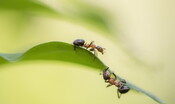Ant colonies have started growing mushrooms when 66 million years old ago an asteroid hit the planet, probably ending the life of the dinosaurs. This curious result emerges from a study, published in the journal Science, conducted by scientists from the Smithsonian’s National Museum of Natural History.
The team, led by Ted Schultz, analyzed the genetic data of hundreds of species of fungi and ants to create detailed evolutionary trees. When humans began growing crops thousands of years ago, experts explain, many animals had already been practicing similar practices for millennia. Using a combined approach, the researchers developed an evolutionary timeline of ant agriculture, pinpointing when the insects would have started cultivating fungi.
“Ants have been practicing agriculture and growing mushrooms since long before the human species emerged – comments Schultz – we could learn something from the successes of this hard-working species”. Currently, the researchers continue, nearly 250 species of ants in the Americas and the Caribbean grow fungi: some collect pieces of fresh vegetation to provide sustenance for the molds, which in turn grow food for the ants called gongylidia.
Over the course of 35 years, researchers collected thousands of genetic samples from across the tropics, which were used to sequence the genetic data of 475 species of fungi and 276 different species of ants. The scientists then created evolutionary trees of the two groups. Comparing the data allowed the authors to determine that fungi and ants have been intertwined for 66 million years, more or less since the collision with the asteroid occurred at the end of the Cretaceous period. The impact, experts say, filled the atmosphere with dust and debris, which blocked the sun and prevented photosynthesis for years, which caused the mass extinction of half of the plant life forms on Earth, but put the ideal conditions for the proliferation of fungi.
The ants fed on these species until, about 27 million years agodeveloped superior agriculture. During that time, a rapidly cooling climate transformed environments around the world. In South America, drier habitats such as wooded savannas and grasslands fractured large swathes of moist tropical forests. When insects brought fungi out of humid forests into drier areas, they isolated them from their ancestral wild populations, promoting genetic differentiation and making them colony-dependent.
“The ants cultivated the mushrooms – concludes Schultz – with the same techniques used by humans for the first crops. It is truly curious and extraordinary to see how ingeniously these small insects were able to interact with the mushrooms”.

IF iDir.com : UHire Oregon
Popular Directory.org : UHire Oregon
Directory 8.org : UHire Oregon
Royal Directory.biz : UHire Oregon
Link Boy.org : UHire Oregon
Traffic Directory.org : UHire Oregon
Steel Directory.net : UHire Oregon
UHire Oregon – 1145 Fall Oaks Ct – Cybo
UHire Oregon in West Linn OR
UHire Oregon, West Linn: website, address, contacts — Directory of companies Cataloxy.us
announceamerica.com/west-linn/legal/uhire-oregon
Social Bookmarking Sites 2021
Angels Directory.com : UHire Oregon
Unique Listing.com : UHire Oregon
Relevant Directory.biz : UHire Oregon
UHire Oregon – Kendall Smith – Medium
Family Dir .com : UHire Oregon
UHire Oregon
Interesting Dir .com : UHire Oregon
Free WebLink.com : UHire Oregon
Lemon Directory .com : UHire Oregon
Oregon.uhire.com – Customer Reviews
Jet Links.com : UHire Oregon
Best Social Bookmarking Sites 2022
Certificate verification problem detected
UHire Pennsylvania – Viesearch
UHire Pennsylvania Reviews, Products and Services
UHire Pennsylvania 133 Queen St 17325
ww7.businessgearup.com/listing/pennsylvania/gettysburg-138/legal/uhire-pennsylvania?usid=16&utid=34803878370